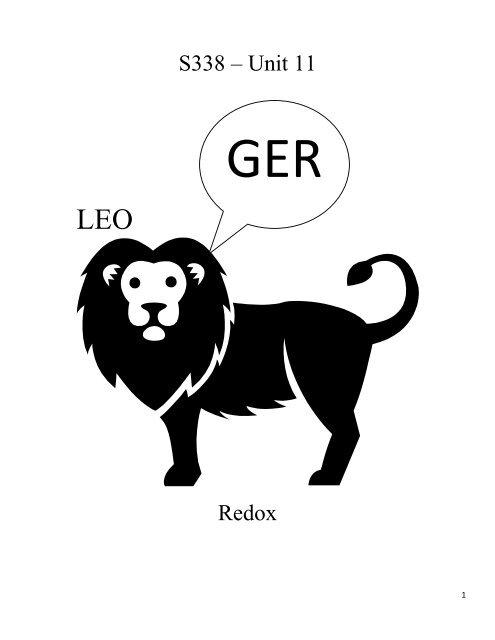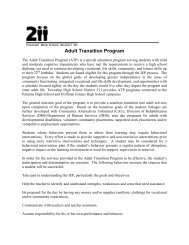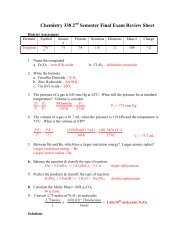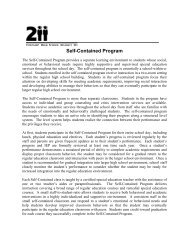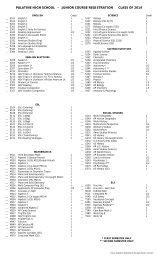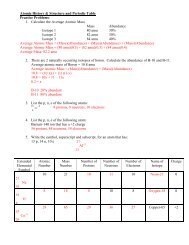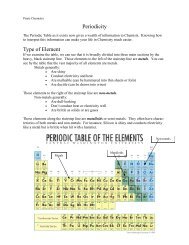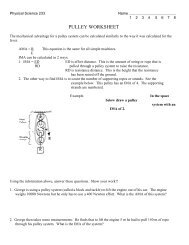You also want an ePaper? Increase the reach of your titles
YUMPU automatically turns print PDFs into web optimized ePapers that Google loves.
<strong>S338</strong> – <strong>Unit</strong> <strong>11</strong><br />
GER<br />
LEO<br />
<strong>Redox</strong><br />
1
20-1 Practice Problems<br />
1. What is the oxidation number of each element in: 6. What is the oxidation number of each element in:<br />
a. H 2 SO 4 a. Mg 3 N 2<br />
b. H 2 S 2 O 7 b. FeCl 3<br />
c. SO 3 c. BaSO 4<br />
2. What is the oxidation number of each element in: 7. What is the oxidation number of each element in:<br />
a. H 3 PO 4 a. NaH 2 PO 4<br />
b. P 4 O 6 b. Na 3 PO 4<br />
c. KH 2 PO 4 c. H 3 BO 3<br />
3. What is the oxidation number of each element in: 8. What is the oxidation number of each element in:<br />
a. Ca(H 2 PO 4 ) 2 a. ZnCO 3<br />
b. CaSO 4 b. Ag 2 CO 3<br />
c. KMnO 4 c. BaF 2<br />
4. What is the oxidation number of each element in: 9. What is the oxidation number of each element in:<br />
a. Be(OH) 2 a. Mg(OH) 2<br />
b. B(OH) 3 b. MgCl 2<br />
c. Si(OH) 4 c. CrCl 3<br />
5. What is the oxidation number of each element in: 10. What is the oxidation number of each element in:<br />
a. NH 3 a. Co(OH) 2<br />
b. SCl 2 b. HAuCl 4<br />
c. Sr(OH) 2 c. HgSO 4<br />
3
<strong>11</strong>. Identify the oxidizing agent and the reducing 16. Identify the element that is oxidized and the<br />
agent in the following reaction:<br />
element that is reduced in the following<br />
reaction:<br />
C + 2Cl 2 CCl 4 2Al + 3Br 2 2AlBr 3<br />
12. Identify the element that is oxidized and the 17. Identify the oxidizing agent and the reducing<br />
element that is reduced in the following<br />
agent in the following reaction:<br />
reaction:<br />
H 2 + Cl 2 2HCI Pb + 2HCl PbCl 2 + H 2<br />
13. Identify the oxidizing agent and the reducing 18. Identify the element that is oxidized and the<br />
agent in the following reaction:<br />
element that is reduced in the following<br />
reaction:<br />
2P + 3Cl 2 2PCI 3<br />
SiO 2 + 2C Si + 2CO<br />
14. Identify the element that is oxidized and the 19. Identify the oxidizing agent and the reducing<br />
element that is reduced in the following<br />
agent in the following reaction:<br />
reaction:<br />
C + H 2 O CO + H 2 CO 2 + 2Mg 2MgO + C<br />
15. Identify the oxidizing agent and the reducing 20. Identify the element that is oxidized and the<br />
agent in the following reaction:<br />
element that is reduced in the following<br />
reaction:<br />
2Fe + 3Cl 2 2FeCl 3 H 2 SO 4 + Zn ZnSO 4 + H 2<br />
4
Balancing <strong>Redox</strong> Equations<br />
Balance the equation using half reactions and oxidation numbers.<br />
1. ___ HNO 3 + ____HI ____NO + ____I 2 + _____H 2 O<br />
2. ____HNO 3 + ____I 2 ____HIO 3 + _____NO 2 + ____H 2 O<br />
3. ____S + ____HNO 3 ____SO 2 + ____NO + _____H 2 O<br />
4. ____SO 3 -2 + _____MnO 4 + _____H + ____SO 4 -2 + _____Mn +2 + _____H 2 O<br />
5. ____NO 3 -1 + ____I 2 + ____H + ____IO 3 -1 + ____NO 2 + ____H 2 O<br />
6. ____HCl + ____KMnO 4 + ____H 2 C 2 O 4 ___CO 2 + ____MnCl 2 + ___KCl + __H 2 O<br />
7. ____H + + ____MnO 4 -1 + ____H 2 C 2 O 4 ____CO 2 + ____Mn +2 + ____H 2 O<br />
5
Name____________________<br />
Activity Series Lab<br />
Oxidation-Reduction reactions, also known as redox reactions, make up an extremely important area of study in<br />
chemistry. These reactions provide energy in electrochemical cells, and have a variety of commercial uses in<br />
batteries and solar cells. In addition, oxidation-reduction reactions are involved in rusting, cleaning agents,<br />
photography and many other processes.<br />
<strong>Redox</strong> reactions can be thought of as reactions in which electrons are exchanged between one species that is<br />
oxidized and another that is reduced. Reduction involves the gain of electrons, while oxidation involves the loss<br />
of electrons. A reduction reaction for a metal ion can be written in the following manner:<br />
+n 0<br />
M + ne - M<br />
The oxidation reaction is written as:<br />
0 +n<br />
M M + ne -<br />
+n<br />
M is typically a metal with +n oxidation state, and n represents the number of electrons (e - )<br />
0<br />
gained. M is the metal in its reduced form.<br />
An activity series of metals is a list that puts in order, metals, according to their relative activity. Metals at the<br />
top of the list are oxidized most readily to their metallic ion. They<br />
+n<br />
tend to remain in ionic form (M). Conversely, metals at the bottom of the list are oxidized with difficulty. Their<br />
metallic ion is relatively active so they tend to be in their<br />
0<br />
reduced form (M). In this investigation, you will establish an activity series based on the ease with which<br />
metallic ions are oxidized. The ions to be studied are Cu +2 , Mg +2 , Zn +2 , Pb +2 , and Ag +1 . The metals to be studied<br />
are Cu, Mg, Zn, Pb, and Ag.<br />
Procedure:<br />
1. In your notebook, state your purpose for this lab activity. Will you support the activity series as it is? Or will<br />
you be bold enough to state that you will somehow find flaws in the existing activity series?<br />
2. Put on your goggles (and lab apron if you’d like).<br />
3. Place a paper towel on the microscope platform, then turn on the microscope.<br />
7
4. Take a strip of zinc and polish one entire side of it with a piece of steel wool. Then, lay it on the paper towel.<br />
5. Take the Magnesium solution contained in the dropper bottle and place one drop of the solution onto the Zinc<br />
strip. Note in your data table if a reaction occurs (write “Y” if a reactions occurs, write “NR” if no reaction<br />
occurs).<br />
6. Repeat step #5 with the remaining solutions (Mg +2 , Cu +2 , Pb +2 , Ag +1 ) making sure that the drops of solution<br />
do not come in contact together.<br />
7. Rinse the Zinc strip in the sink, dry it and set it aside.<br />
8. Repeat steps 4 through 7, but perform the procedure with the following metal and solution combinations…<br />
Mg strip with Zn, Cu, Pb and Ag solutions<br />
Cu strip with Zn, Mg, Pb and Ag solutions<br />
Pb strip with Zn, Mg, Cu and Ag solutions<br />
Ag strip with Zn, Mg, Cu and Pb solutions<br />
9. Once you are done with all the metal strips and the solutions, clean up your table, wash your hands, then<br />
return the Silver strip to your teacher.<br />
Data Table – Activity Series Lab<br />
Zn<br />
Mg<br />
Cu<br />
Pb<br />
Ag<br />
Zn +2 Mg +2 Cu +2 Pb +2 Ag +1<br />
X<br />
X<br />
X<br />
X<br />
X<br />
8
1. Purpose: State your purpose for this lab.<br />
Activity Series Lab – Lab Report Details – what to include<br />
(typed):<br />
2. Data: Present your data in an organized form (re-create your data table with your results written in it. This<br />
can be easily done by using the table function in MS Word).<br />
3. Analysis:<br />
a. Go through step-by-step where each atom should be located in the activity series. Place the atoms in<br />
order from most easily oxidized to least easily oxidized (hint: the most easily oxidized atom is the one<br />
that likes to go into its ionic state. Example: Mg Mg +2 + 2e - Another hint: you need to look at<br />
reactivities to determine the order). This list will be your experimental activity series.<br />
b. Provide THOROUGH evidence for why you placed your atoms in the order you did for part 3a. For<br />
example – let’s say you placed Mg above all the other elements in your activity series. How do you<br />
know this? What experimental evidence do you have to support your answer?<br />
c. Write out a balanced redox equation for each of the reactions that took place. Remember that only<br />
half of the reactions will work, so you should have ten equations written.<br />
4. Conclusion:<br />
a. Restate your purpose.<br />
b. Restate your experimental activity series (the list you formulated from your data).<br />
c. Examine your experimental activity series and compare it to the actual activity series (this was given<br />
to you on a hand-out when we were studying types of reactions, remember? If you can’t find yours, then<br />
you can find it in your chemistry textbook). How do they compare?<br />
d. Did your experiment support your purpose of either confirming or contradicting the existing activity<br />
series? How so?<br />
e. Would you change anything about the procedure to improve your results? If so – what would you<br />
change and why? If not – why wouldn’t you change anything?<br />
(over) →<br />
9
5. Post Lab Questions:<br />
a. Would it be a good idea to store a copper metal ion solution (Cu(NO 3 ) 2 (aq), for example) in an<br />
aluminum can? Why or why not?<br />
b. Would it be a good idea to store an aluminum metal ion solution (Al(NO 3 ) 3 (aq), for example) in<br />
a copper can? Why or why not?<br />
5c. Although silverware is beautiful, it tarnishes with time. Tarnish results from a chemical reaction in which<br />
silver reacts with hydrogen sulfide and oxygen in the air to form silver sulfide:<br />
Ag (s) + H 2 S (g) + O 2(g) Ag 2 S (s) + H 2 O (l)<br />
Balance the equation using half-reactions and oxidation numbers. Label the half-reactions as either<br />
oxidation or reduction.<br />
Silver will also react with various sulfides found in rubber, egg yolks, and other substances, including some<br />
vegetables. There are always traces of hydrogen sulfide in the atmosphere. Thus, it is important you protect<br />
silver items by wrapping them in protective cloth or placing them in an environment containing substances that<br />
will absorb the hydrogen sulfide. If silverware does become tarnished, how can it be restored?<br />
• Get a glass baking dish. Line it with a piece of aluminum foil. Place your tarnished silver on top of<br />
the aluminum foil. It must be in contact with the foil for this to work!<br />
• Boil some water on a stove. Once in comes to a rolling boil, add about 1 cup of baking soda for every<br />
gallon of water. Be careful, though! The water tends to boil over quickly so add the baking soda slowly!<br />
• Pour the hot water/baking soda solution into the pan containing the aluminum foil and tarnished silver.<br />
Moderately tarnished pieces will be clean within seconds, while badly tarnished pieces might take over an hour<br />
to work.<br />
How does it work?<br />
The silverware is cleaned by an redox reaction in which silver sulfide produces elemental silver according to<br />
the following equation:<br />
Al (s) + Ag 2 S (s) + H 2 O (l) Ag (s) + Al(OH) 3(aq) + H 2 S (g)<br />
Balance the equation using half-reactions and oxidation numbers. Label the half-reactions as either<br />
oxidation or reduction.<br />
In the electrochemical process, the silver, surrounded by the electrolyte (NaHCO 3 , baking soda), forms<br />
one plate of an electric cell and the aluminum forms the other. The equation suggests that hydrogen sulfide gas<br />
(the gas produced in rotting eggs) is evolved in small quantities. If this reaction occurs, then you may be able to<br />
detect the odor of rotten eggs by removing part of the aluminum from a piece of silver as the reaction is<br />
proceeding.<br />
10
Name ______________________________________<br />
Voltaic Cells Lab<br />
Data and Analysis<br />
A. For each cell below, label the following on the diagram:<br />
1 & 2. The identity of the metal<br />
3. The reading on the voltmeter<br />
4. The direction of the electron flow through the wires of the voltmeter<br />
5. Label the metal that is the cathode and the metal that is the anode.<br />
6. Label the metal that is oxidizing and the metal that is being reduced<br />
7. Draw the direction in which each ion in the salt bridge moves.<br />
8. Calculate the electrical potential of the cell (show work)<br />
9. Write the half reactions and a balanced redox reaction for the cell.<br />
Zn/Zn +2 – Cu/Cu +2 Cell<br />
1<br />
.<br />
2<br />
.<br />
.<br />
3<br />
.<br />
13
Zn/Zn +2 – Pb/Pb +2 Cell<br />
1<br />
.<br />
2<br />
.<br />
3<br />
.<br />
Zn/Zn +2 – Mg/Mg +2 Cell<br />
14
1<br />
.<br />
2<br />
.<br />
Pb/Pb +2 – Mg/Mg +2 Cell<br />
3<br />
.<br />
1<br />
.<br />
2<br />
.<br />
3<br />
.<br />
Mg/Mg +2 – Cu/Cu +2 Cell<br />
15
1<br />
.<br />
2<br />
.<br />
3<br />
.<br />
16
Voltaic Cells Worksheet<br />
On each of the following diagrams, label: 1. the anode, 2. the cathode, 3. Direction of electron<br />
flow, 4. Direction of anion and cation flow through the salt bridge, and 5. Which electrode<br />
should be increasing in mass. Then write out the half-reactions, the overall reaction and<br />
calculate the net voltage of the cell.<br />
1)<br />
A = Cr B = Cr +3<br />
E = Fe D = Fe +2<br />
2)<br />
A = Sn B = Sn +2<br />
E = Al D = Al +3<br />
3)<br />
A = Ag B = Ag +1<br />
E = Cu D = Cu +2<br />
17


